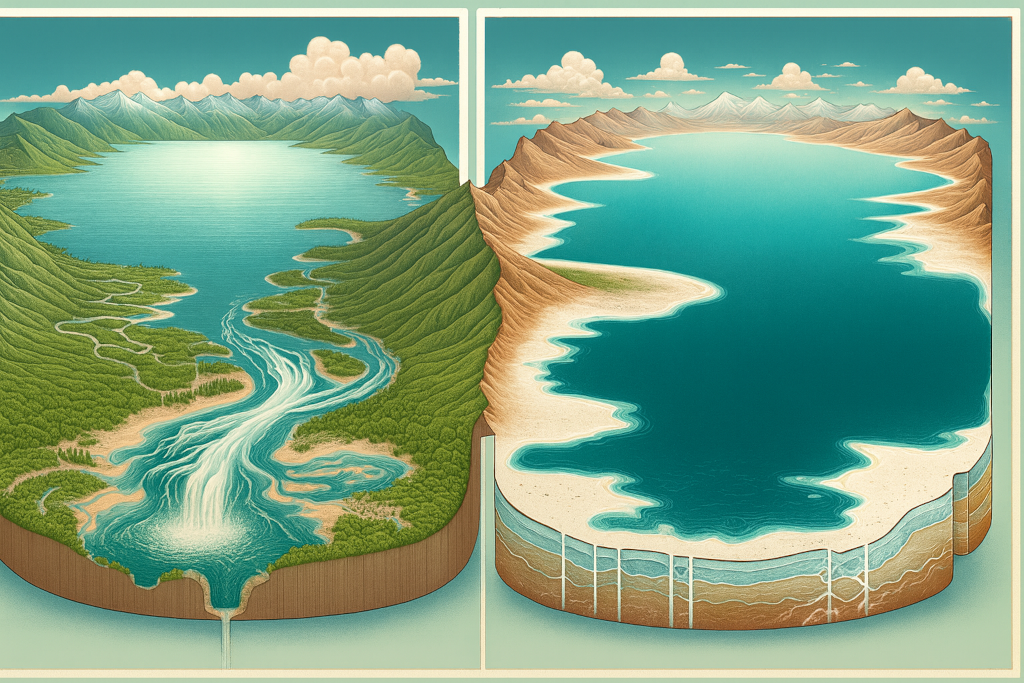Have you ever stood at the edge of a vast, shimmering lake and wondered: “How can one of the largest lakes in North America be full of salt, while others even bigger are fresh?” It seems counterintuitive—but here’s the twist. Size has almost nothing to do with it.
That might sound strange. After all, when we think about huge bodies of water like the Great Salt Lake or Lake Superior, we tend to assume their size alone dictates what kind of water they hold. But it turns out, what makes a lake fresh or salty comes down to a much more dynamic and fascinating balancing act: its hydrology.
The unexpected force behind lake salinity
Not all lakes are created equal. Some constantly flush themselves out, while others trap water for thousands of years. The difference? Outlets.
Lakes with outflows, known as non-endorheic lakes, are like open circuits. Rivers flow in, rivers flow out—and with that outflow, minerals and salts get carried away. But when a lake becomes endorheic—meaning closed, with no outlet—everything changes.
Rain and rivers still bring in water, but now there’s nowhere for it to go… except up—through evaporation. Water leaves, but salt doesn’t. Over time, minerals concentrate, and a freshwater lake begins shifting toward salt.
Still thinking size matters? Think again.
Let’s compare two dramatically different lakes:
- Lake Superior: At a whopping 82,100 km², it’s one of the largest freshwater lakes in the world. Why is it fresh? Because it has plenty of outflow rivers that constantly cycle water (and minerals) through.
- Great Salt Lake: Much smaller—around 8,500 km² at its peak—but it’s famously salty. Why? It’s an endorheic lake—no outflow. That means evaporation dominates, minerals concentrate, and salinity rises.
You could make a lake ten times the size of the Great Salt Lake, and it could still stay fresh—if it had enough outflow to flush out minerals. Conversely, a teeny-tiny closed lake could become saltier than the ocean, given enough time and evaporation.
Lessons from ancient waters
History backs this up. Thousands of years ago, a massive freshwater lake called Lake Bonneville covered much of what is now Utah. It was huge—far larger than the modern Great Salt Lake. But as it lost its natural outlet through geological shifts, inflow slowed, and evaporation took over. The result: the transformation into today’s saline Great Salt Lake.
Meanwhile, smaller lakes elsewhere—like Lake Taupō in New Zealand or Crater Lake in Oregon—remain fresh not because of size, but because of robust water exchange systems.
Experiments, patterns, and proof
Hydrologists and environmental scientists have studied salinization in diverse climates—from high-altitude lakes in Andean salt flats to desert basins in Africa’s Danakil Depression. Across regions and decades, the pattern repeats:
- No outlet? Salinity increases steadily over time, especially in arid regions.
- Regular outflow? Salinity stays low, even if the lake’s rate of evaporation is high.
A 2019 study from the U.S. Geological Survey tracked salinity in terminal lakes across western North America. It confirmed what geologists had long suspected: elevation changes, tectonic activity, and climate-driven alterations in inflow/outflow—not size—make or break a lake’s salinity status.
So what does this mean for the future of lakes?
Climate change is set to shift hydrological patterns globally. Some freshwater lakes may lose their outlets due to drying rivers or declining snowfall, inching toward salinization. Others may receive rerouted inflows from increased rainfall or glacier melting, keeping them fresh against the odds.
In short, a lake’s future has more to do with flow than size. If you’re picturing a salty lake, don’t ask how big it is—ask where its water is going.
The water flows smarter than you’d think
So here’s the bottom line: any time you find yourself near a mysterious saltwater lake, don’t assume it must be “too big” to be fresh. That’s a myth. Instead, look around. Are there rivers flowing out? If not… that lake is on the slow, steady path to salt.
Nature doesn’t care about size—it cares about balance. And in lakes, that balance comes down to what moves and what stays put.




Leave a Comment